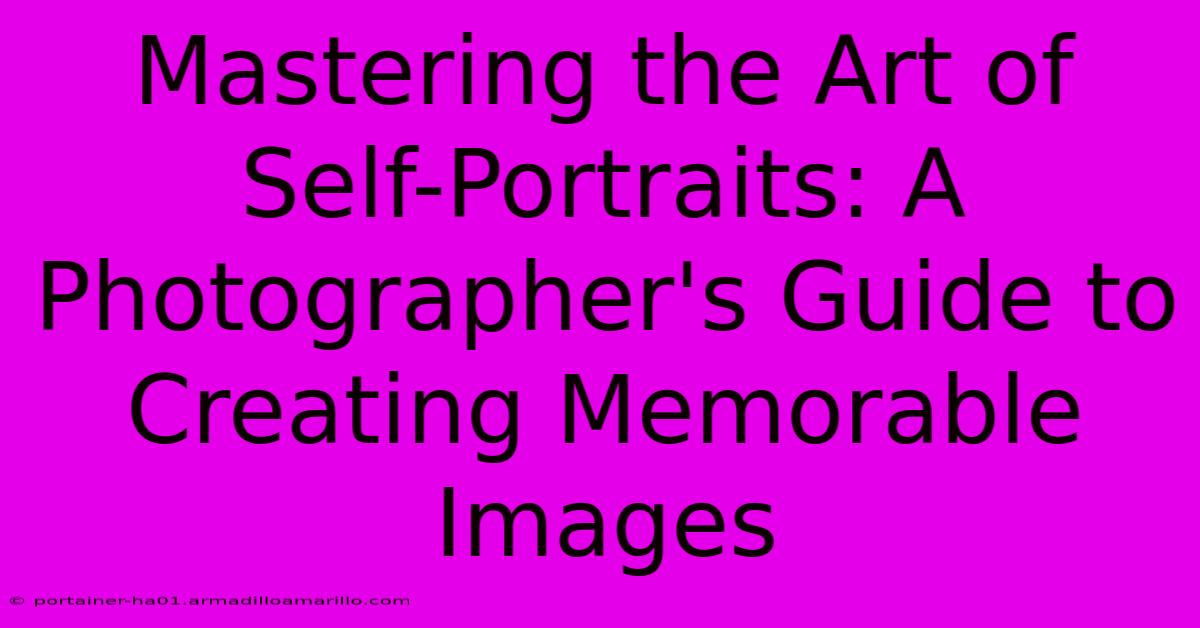Mastering The Art Of Self-Portraits: A Photographer's Guide To Creating Memorable Images

Table of Contents
Mastering the Art of Self-Portraits: A Photographer's Guide to Creating Memorable Images
Self-portraits. They're more than just selfies; they're a powerful tool for self-expression, a chance to explore your creativity, and a way to build a strong portfolio. Whether you're a seasoned professional or just starting out, mastering the art of the self-portrait requires understanding both technical skills and artistic vision. This comprehensive guide will walk you through everything you need to know to create truly memorable images.
Understanding Your Vision: Planning the Perfect Self-Portrait
Before you even pick up your camera, consider the story you want to tell. What message are you trying to convey? What mood or emotion do you want to evoke? This pre-visualization is crucial. Ask yourself:
- What's the concept? Is it a whimsical, playful image? A serious, introspective one? A bold, statement piece?
- What's the setting? Will you shoot indoors or outdoors? What kind of background will best complement your subject (you!)? Consider natural light, textures, and colors.
- What's the message? What do you want viewers to feel or think when they see your self-portrait?
Mastering the Technical Aspects: Camera Settings and Equipment
While artistic vision is key, technical proficiency is equally important. Let's explore the essential aspects:
Choosing the Right Equipment:
- Camera: Any camera will do, from a smartphone to a professional DSLR. The quality of your images will depend more on your composition and lighting than on the equipment itself.
- Lenses: A versatile 50mm or 35mm lens is ideal for self-portraits, offering a good balance between perspective and depth of field. Experiment with different lenses to find what suits your style.
- Tripod: This is indispensable for sharp, well-composed images. A remote shutter release or your camera's self-timer will prevent camera shake.
- Lighting: Natural light is often the best option, but consider using reflectors or diffusers to soften harsh shadows. Artificial lighting, like speedlights or continuous lighting, offers more control, particularly in low-light situations.
Essential Camera Settings:
- Aperture: A wide aperture (low f-number like f/2.8 or f/1.4) will create a shallow depth of field, blurring the background and emphasizing you. A narrower aperture (higher f-number) will keep both you and the background in focus.
- Shutter Speed: This depends on your lighting conditions and aperture. Use a fast enough shutter speed to avoid blur, especially if you're using a wide aperture.
- ISO: Keep your ISO as low as possible to minimize noise in your images. If your lighting conditions require a higher ISO, try to minimize noise in post-processing.
- Focus: Use manual focus or autofocus to ensure your face is sharp. Consider using a focus point closer to your eyes for a more impactful image.
Posing and Composition: Techniques for a Stunning Self-Portrait
Your pose significantly influences the mood and impact of your self-portrait. Here are some tips:
- Experiment with angles: Try different angles—high, low, side profiles—to find what best captures your personality and the emotion you want to convey.
- Body language: Your posture and hand placement contribute to the overall message. A relaxed pose can convey confidence, while a more thoughtful pose can suggest introspection.
- Facial expressions: A subtle smile, a serious gaze, or a playful expression—each creates a different feeling. Experiment to find what best fits your vision.
- Rule of thirds: Place yourself off-center in the frame, following the rule of thirds for a more visually appealing composition.
- Leading lines: Use natural lines in your environment to draw the viewer's eye toward you.
- Negative space: Don't overcrowd the frame. Use negative space to create a sense of balance and emphasize your subject (you!).
Post-Processing: Enhancing Your Masterpiece
Post-processing is an integral part of creating a stunning self-portrait. Use editing software like Adobe Lightroom or Photoshop to:
- Adjust exposure and contrast: Optimize the brightness and darkness levels to create a balanced image.
- Fine-tune colors and saturation: Enhance the colors to complement the overall mood.
- Reduce noise and sharpen: Improve image clarity and reduce graininess.
- Retouch imperfections (optional): While authenticity is important, subtle retouching can enhance your self-portrait.
Promoting Your Work: Sharing Your Self-Portraits
Once you've created your masterpiece, it's time to share it with the world!
- Build an online portfolio: Showcase your best self-portraits on a personal website or online platform.
- Engage with the photography community: Share your work on social media platforms and participate in online forums to gain feedback and connect with other photographers.
- Enter photography contests: Consider submitting your work to competitions to gain recognition and exposure.
- Print your work: Consider printing high-quality prints of your favorite self-portraits to display in your home or studio.
Mastering self-portrait photography is a journey, not a destination. By understanding your vision, mastering the technical aspects, and refining your post-processing skills, you can create stunning and memorable self-portraits that truly reflect your unique personality and artistic expression. So grab your camera, experiment, and start creating!

Thank you for visiting our website wich cover about Mastering The Art Of Self-Portraits: A Photographer's Guide To Creating Memorable Images. We hope the information provided has been useful to you. Feel free to contact us if you have any questions or need further assistance. See you next time and dont miss to bookmark.
Featured Posts
-
Unlock The Secret To Stunning Hot Pink Wedding Bouquets A Guide To Steal The Show
Feb 08, 2025
-
Unlocking The Enigmatic Size Of Polaroid Photos From Vintage To Modern
Feb 08, 2025
-
Unlock The Secrets Of Persuasion The Psychology Of Irresistible Influence
Feb 08, 2025
-
Elevate Your Design Uncover The Hex Code Enigma Of Pantone 158
Feb 08, 2025
-
5 D And D Unicorn Subclasses That Will Bring Wonder And Grace To Your Campaign
Feb 08, 2025
